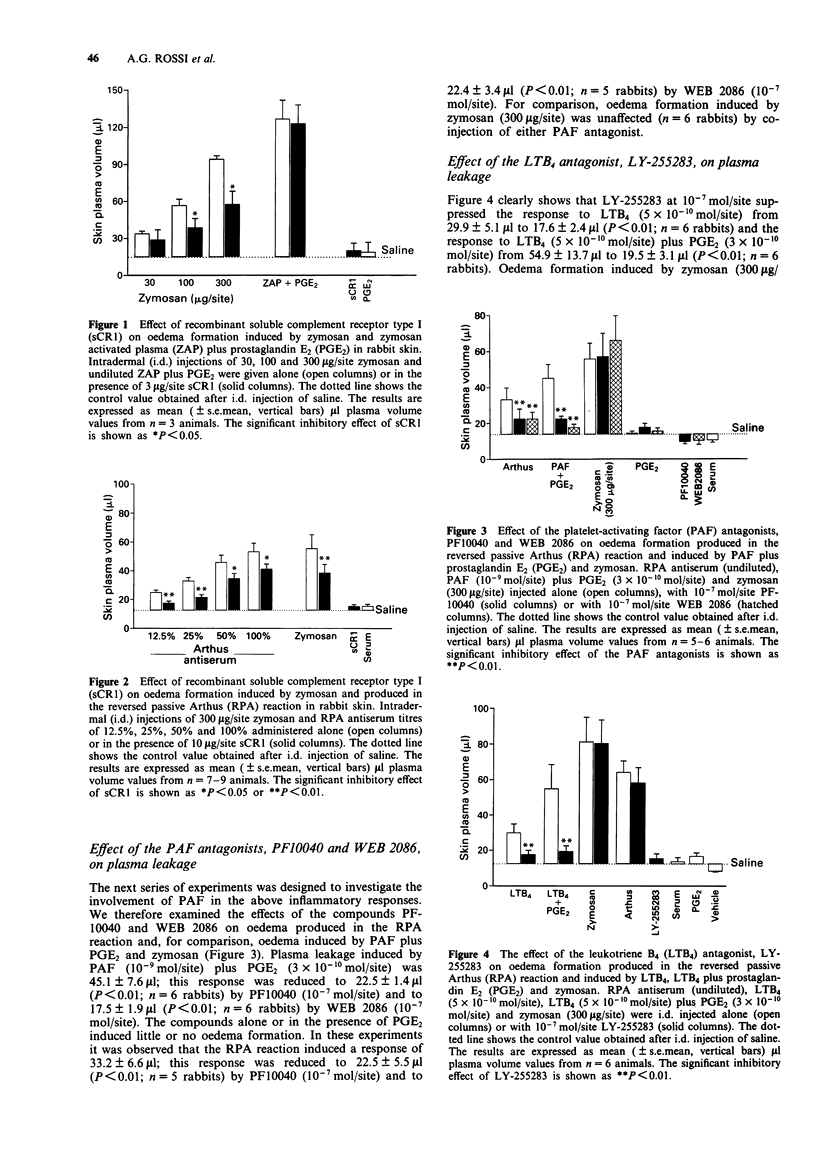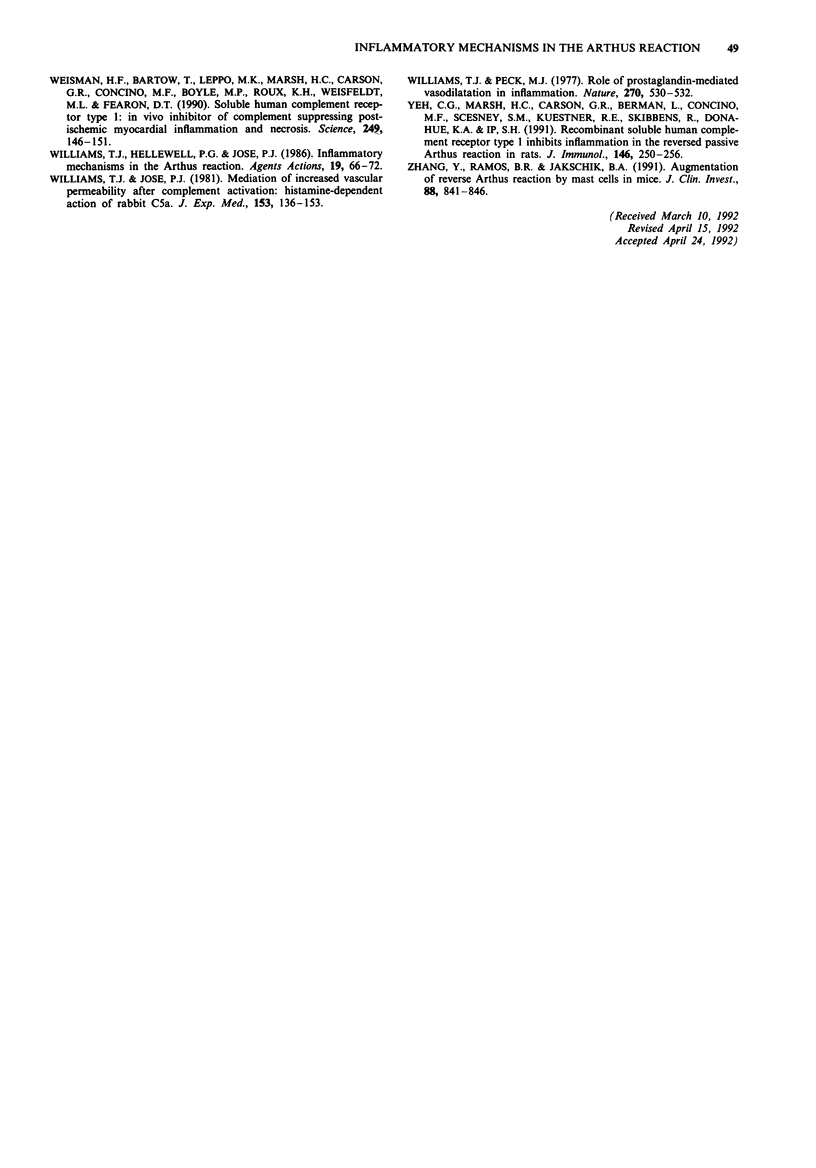Abstract
1. The mechanisms underlying oedema formation induced in a reversed passive Arthus (RPA) reaction and, for comparison, in response to zymosan in rabbit skin were investigated. 2. Oedema formation at skin sites was quantified by the accumulation of intravenously-injected 125I-labelled human serum albumin. 3. Recombinant soluble complement receptor type 1 (sCR1), administered locally in rabbit skin, suppressed oedema formation induced in the RPA reaction and by zymosan. 4. The platelet-activating factor (PAF) antagonists, WEB 2086 and PF10040 administered locally, inhibited oedema formation induced in the RPA reaction and by PAF but not by zymosan. 5. A locally administered leukotriene B4 (LTB4) antagonist, LY-255283, inhibited oedema formation induced by LTB4 but did not inhibit oedema responses to PAF, zymosan or the RPA reaction. 6. The results demonstrate a role for complement in oedema formation in both the RPA reaction and in response to zymosan. An important contribution by PAF is indicated in the RPA reaction but not in response to zymosan whereas no evidence was obtained to suggest a role for LTB4 in either inflammatory response.
Full text
PDF





Selected References
These references are in PubMed. This may not be the complete list of references from this article.
- Berkenkopf J. W., Weichman B. M. Comparison of several new 5-lipoxygenase inhibitors in a rat Arthus pleurisy model. Eur J Pharmacol. 1991 Jan 25;193(1):29–34. doi: 10.1016/0014-2999(91)90196-w. [DOI] [PubMed] [Google Scholar]
- Braquet P., Touqui L., Shen T. Y., Vargaftig B. B. Perspectives in platelet-activating factor research. Pharmacol Rev. 1987 Jun;39(2):97–145. [PubMed] [Google Scholar]
- Camussi G., Pawlowski I., Saunders R., Brentjens J., Andres G. Receptor antagonist of platelet activating factor inhibits inflammatory injury induced by in situ formation of immune complexes in renal glomeruli and in the skin. J Lab Clin Med. 1987 Aug;110(2):196–206. [PubMed] [Google Scholar]
- Casals-Stenzel J., Muacevic G., Weber K. H. Pharmacological actions of WEB 2086, a new specific antagonist of platelet activating factor. J Pharmacol Exp Ther. 1987 Jun;241(3):974–981. [PubMed] [Google Scholar]
- Cochrane C. G., Müller-Eberhard H. J., Aikin B. S. Depletion of plasma complement in vivo by a protein of cobra venom: its effect on various immunologic reactions. J Immunol. 1970 Jul;105(1):55–69. [PubMed] [Google Scholar]
- Collins P. D., Jose P. J., Williams T. J. The sequential generation of neutrophil chemoattractant proteins in acute inflammation in the rabbit in vivo. Relationship between C5a and proteins with the characteristics of IL-8/neutrophil-activating protein 1. J Immunol. 1991 Jan 15;146(2):677–684. [PubMed] [Google Scholar]
- Fearon D. T., Wong W. W. Complement ligand-receptor interactions that mediate biological responses. Annu Rev Immunol. 1983;1:243–271. doi: 10.1146/annurev.iy.01.040183.001331. [DOI] [PubMed] [Google Scholar]
- HUMPHREY J. H. The mechanism of Arthus reactions. I. The role of polymorphonuclear leucocytes and other factors in reversed passive Arthus reactions in rabbits. Br J Exp Pathol. 1955 Jun;36(3):268–282. [PMC free article] [PubMed] [Google Scholar]
- Hellewell P. G., Williams T. J. A specific antagonist of platelet-activating factor suppresses oedema formation in an Arthus reaction but not oedema induced by leukocyte chemoattractants in rabbit skin. J Immunol. 1986 Jul 1;137(1):302–307. [PubMed] [Google Scholar]
- Iida K., Nussenzweig V. Complement receptor is an inhibitor of the complement cascade. J Exp Med. 1981 May 1;153(5):1138–1150. doi: 10.1084/jem.153.5.1138. [DOI] [PMC free article] [PubMed] [Google Scholar]
- Issekutz A. C., Szpejda M. Evidence that platelet activating factor may mediate some acute inflammatory responses. Studies with the platelet-activating factor antagonist, CV3988. Lab Invest. 1986 Mar;54(3):275–281. [PubMed] [Google Scholar]
- Jose P. J., Forrest M. J., Williams T. J. Detection of the complement fragment C5a in inflammatory exudates from the rabbit peritoneal cavity using radioimmunoassay. J Exp Med. 1983 Dec 1;158(6):2177–2182. doi: 10.1084/jem.158.6.2177. [DOI] [PMC free article] [PubMed] [Google Scholar]
- José P. J., Forrest M. J., Williams T. J. Human C5a des Arg increases vascular permeability. J Immunol. 1981 Dec;127(6):2376–2380. [PubMed] [Google Scholar]
- Mollnes T. E., Lachmann P. J. Regulation of complement. Scand J Immunol. 1988 Feb;27(2):127–142. doi: 10.1111/j.1365-3083.1988.tb02331.x. [DOI] [PubMed] [Google Scholar]
- Ross G. D., Medof M. E. Membrane complement receptors specific for bound fragments of C3. Adv Immunol. 1985;37:217–267. doi: 10.1016/s0065-2776(08)60341-7. [DOI] [PubMed] [Google Scholar]
- STETSON C. A., GOOD R. A. Studies on the mechanism of the Shwartzman-phenomenon; evidence for the participation of polymorphonuclear leucocytes in the phenomenon. J Exp Med. 1951 Jan;93(1):49–63. doi: 10.1084/jem.93.1.49. [DOI] [PMC free article] [PubMed] [Google Scholar]
- Snyder D. W., Fleisch J. H. Leukotriene receptor antagonists as potential therapeutic agents. Annu Rev Pharmacol Toxicol. 1989;29:123–143. doi: 10.1146/annurev.pa.29.040189.001011. [DOI] [PubMed] [Google Scholar]
- WARD P. A., COCHRANE C. G. BOUND COMPLEMENT AND IMMUNOLOGIC INJURY OF BLOOD VESSELS. J Exp Med. 1965 Feb 1;121:215–234. doi: 10.1084/jem.121.2.215. [DOI] [PMC free article] [PubMed] [Google Scholar]
- Warren J. S., Mandel D. M., Johnson K. J., Ward P. A. Evidence for the role of platelet-activating factor in immune complex vasculitis in the rat. J Clin Invest. 1989 Feb;83(2):669–678. doi: 10.1172/JCI113931. [DOI] [PMC free article] [PubMed] [Google Scholar]
- Wedmore C. V., Williams T. J. Control of vascular permeability by polymorphonuclear leukocytes in inflammation. Nature. 1981 Feb 19;289(5799):646–650. doi: 10.1038/289646a0. [DOI] [PubMed] [Google Scholar]
- Weisman H. F., Bartow T., Leppo M. K., Marsh H. C., Jr, Carson G. R., Concino M. F., Boyle M. P., Roux K. H., Weisfeldt M. L., Fearon D. T. Soluble human complement receptor type 1: in vivo inhibitor of complement suppressing post-ischemic myocardial inflammation and necrosis. Science. 1990 Jul 13;249(4965):146–151. doi: 10.1126/science.2371562. [DOI] [PubMed] [Google Scholar]
- Williams T. J., Hellewell P. G., Jose P. J. Inflammatory mechanisms in the Arthus reaction. Agents Actions. 1986 Oct;19(1-2):66–72. doi: 10.1007/BF01977260. [DOI] [PubMed] [Google Scholar]
- Williams T. J., Jose P. J. Mediation of increased vascular permeability after complement activation. Histamine-independent action of rabbit C5a. J Exp Med. 1981 Jan 1;153(1):136–153. doi: 10.1084/jem.153.1.136. [DOI] [PMC free article] [PubMed] [Google Scholar]
- Williams T. J., Peck M. J. Role of prostaglandin-mediated vasodilatation in inflammation. Nature. 1977 Dec 8;270(5637):530–532. doi: 10.1038/270530a0. [DOI] [PubMed] [Google Scholar]
- Yeh C. G., Marsh H. C., Jr, Carson G. R., Berman L., Concino M. F., Scesney S. M., Kuestner R. E., Skibbens R., Donahue K. A., Ip S. H. Recombinant soluble human complement receptor type 1 inhibits inflammation in the reversed passive arthus reaction in rats. J Immunol. 1991 Jan 1;146(1):250–256. [PubMed] [Google Scholar]
- Zhang Y., Ramos B. F., Jakschik B. A. Augmentation of reverse arthus reaction by mast cells in mice. J Clin Invest. 1991 Sep;88(3):841–846. doi: 10.1172/JCI115385. [DOI] [PMC free article] [PubMed] [Google Scholar]


